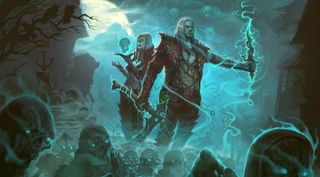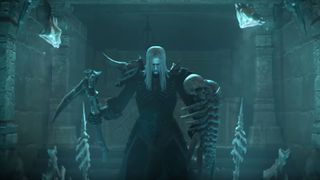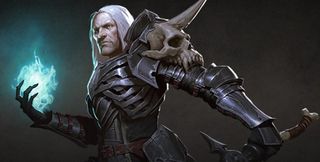Diablo 3's Necromancer is faster, more aggressive, has full suite of skills and runes
Senior producers Rob Foote and Travis Day discuss the newly adapted and modernised class.

Last week, we learned that Diablo 3's new Necromancer class, an adaptation of the series' versatile grade, is coming sooner than expected. Due tomorrow, June 27, players can expect a faster, harder hitting variation of what's come before—a modernised creation that senior producer Travis Day says was a "huge honour" to have worked on.
Alongside the game's other senior producer Rob Foote, we spoke about Diablo 3's Necromancer and its place withing the action role-player's neighbouring classes, what's different this time round, and how its scope pays deference to the series' 20th anniversary.

Rob Foote is a senior producer on Diablo 3, having kicked off his Blizzard career as a QA tester back in 2000. Travis Day is also a senior producer on Blizzard's role-playing hell world, having held a variety of positions at EA, Activision and Cloud Imperium Games among other companies beforehand.
PC Gamer: How have you managed to turn the Necromancer class around much quicker than you anticipated? Was it easier than you anticipated or did you manage to come together much more quickly?
Rob Foote: Well, I mean I think... we knew it was an ambitious goal when we announced at Blizzcon and I think the beta was purposefully very long—it was one of our longest beta, PTR cycles, we’ve ever done for a patch. We got a lot of great feedback, and as it developed over the first half of this year we started feeling very confident. We came together faster than we could have hoped, and we are very happy to have it arrive sooner.
This is the 20th anniversary this year, and we definitely wanted to make sure that, speaking as a producer, the content fit within the scope of this year and it’s always great to overdeliver.
So when you first sat down and started contenting out the Necromancer in Diablo 3, what did you want to change and update about it?
Travis Day: Yeah the Diablo 2 Necromancer was one of my favourite characters just in general in an RPG and in gaming. I remember a lot of time spent playing that character with my brother back in the old days. But there were certainly a lot of things that I remember that were not the best back in Diablo 2 like taking my Necromancer and all of my awesome skeletons into Nightmare and Hell and then watching them all die in one attack.
The biggest gaming news, reviews and hardware deals
Keep up to date with the most important stories and the best deals, as picked by the PC Gamer team.
So... we wanted to start by addressing some of the issues—but there was also a lot to just adapt to bring into Diablo 3. The pacing of the game is very different, so when we started developing corpses, which we didn’t even have a concept of for Diablo 3, in addition to just the assorted skills, we started finding that the timing, the pacing of some of the old skills didn’t really match our expectation for our game.
Certainly adapting the skeletons, the curses, the assorted skills that players were familiar with, and trying to find a way to make them make sense, like Corpse Explosion; one of our first iterations of it was closer to Diablo 2 where we blow up a single corpse at a time, but we found that when you kill monsters, some are much quicker in Diablo 3 that you quickly ended up spending too much time just pushing that one button.
There was a lot of sort of acclimating the class to a different environment, but I think we’re all really happy with the end result of all the work and iteration that we’ve put in.

It’s interesting to see the class move away from poison and that sort of archetype to a more direct damage and focusing on that but do you think that suits Diablo 3 more as an action game?
Travis Day: Yeah, absolutely. I think we definitely spent a lot of time trying to figure out—what do we want to bring forward, what do we not feel like really has a place, and whenever poison came up, a lot of people really like “Oh Poison! Poison Nova!” and we were like “What do you love about Posion?” they were like... “I love Poison Nova!”—and we’re like “Okay...” (Laughs) “That’s fair but... I think we can do better...”
We did use a lot of those as like, jumping off points—like we have Death Nova and it has an assortment of rune variants on it; one of them is a... a couple of them are Decay themed which is the poison damage type but not the big green poison damage-over-time type of stuff that players are accustomed to in Diablo 2.
There were certainly some things like that—Iron Maiden is another example that comes up all the time, whenever we talk about curses, people are like “Oh, what about Iron Maiden?” and we’re like “Yeah... forms isn’t the most exciting thing in Diablo 3”—the pace of the game is so much different, so there were certainly a lot of things that we tried and iterated on until we got to where we are now.
And like Rob mentioned, we had a really long PTR and that helped us dial in the things that we wanted to push further or accentuate more.
So when you were developing the Necromancer, were you developing him as a solo player or as intended as someone who could fit in as a co-op player and do a certain role?
Travis Day: I mean really we just wanted to take the really iconic elements of the Necromancer, this dark caster, commander of the dead and sort of find ways to deliver on the fantasy. I can’t say that we really targeted it at either single or multiplayer, we just thought “What would be cool?” “What do the fans want?” “What does our team want to do?”—and that was really sort of just the design point really for all of the skills and all of the runes and passives and sets was just what did we think would be awesome?
And then really whether players like it more in singleplayer or multiplayer—I personally think it’ll work well for all of that, but we definitely don’t set out to go “Alright, this is a multiplayer character...” we just go “These things look sweet, let’s make those!” “Is it fun?”
Rob Foote: Yeah, we really wanted also to make the Necromancer a class that people were going to be excited about and felt complete and on par with all of our other classes, so like Travis mentioned—let’s give them the full suite of skills, runes... it’s going to be shipping with four complete sets like the other classes.
We also obviously have the Necromancer playable from Act 1 through Act 5—including a new cinematic that you saw at the beginning of June that we released on the internet and yeah—ideally players who didn’t know... would think that the Necromancer was part of the original suite of all the other classes, it feels that... on par with the rest.
That’s really cool. And of course you’ve got to design all the armour and stuff for him—obviously it’s been influenced by Diablo 2 but how was the returning to the bones and all of that kind of aesthetic?
Rob Foote: Well, the artists were very excited. I mean honestly the team, when we were selecting a class for the 20th anniversary, the Necromancer was number one by...
Travis Day: Overwhelmingly.
Rob Foote: Yeah. It wasn’t unanimous but virtually unanimous, and the artists were obviously... we understand what the Necromancer is, it’s a very powerful class in terms of imagery and in terms of theme, so very quickly the concept folks went to work and started jamming out amazing images for them that inspired the character artists to make those great sets. Honestly the hardest part was selecting only four sets for the class-based sets.
It’s a cool way to refresh the entire game, a character class, for a game like Diablo where skills are so important—how do you think the game plays differently with the Necromancer as opposed to the other classes?
Travis Day: I think it’s pretty robust. Really one of goals, setting out early was to make sure that we had as many different gameplay styles represented as possible, and that they all felt meaningfully different—so the four sets are sort of the... the class sets, we sort of reinforce that with.
We’ve got the Pets set where it’s all about commanding your skeletons and your army of the dead, there’s the melee-focused set which is not explicitly melee, but it’s very close range like getting into the thick of things and using your Nova skills and your Grim Scythe. Then there’s the Blood set which is just focused on the blood-themed skills, using your health to cast these really powerful, destructive magics, and then we have the Plague set, which is really focused on using Corpse skills and Bone Sphere—which is also sort of a throwback to Diablo 2.
So I think we’ve got a really diverse line-up. I think that there’s a lot of different ways to build your Necromancer, so I don’t really know what people will end up doing themselves. I’m going to use probably the melee set, but then I know a lot of people in general have loved the Pet set too, and I think everyone’s just really excited to get it into the hands of the players next week and to see what they think.
I was going to ask actually what your personal favourite skills are...
Travis Day: My personal favourite? I really, really enjoy playing the Melee set—I think Grim Scythe and Bone Nova with the Aura of Frailty are really awesome. I think Corpse Explode is just incredibly fun to use.
But really I think everyone on the team has got their own favourite—I know...
Rob Foote: Yeah, I mean for me I totally embrace the pet aspect of the Necromancer, so Revive is really awesome—it does satisfy the fantasy of the enemies that you’ve slain, returning them from the dead to fight alongside of you is just really, really cool. And it definitely brings you back to playing D2.
PCG Tom: You mentioned this long beta period. What sort of things changed and why did they change during that beta period?
Travis Day: Oh wow. So really when we make our characters, our skills and our items, we really just try to think “What would be cool?” “What’s an awesome fantasy?” “How do we deliver that in gameplay?”—and a lot of the time we just go “OK, this sounds awesome, let’s make it...”—and we have no idea about what’s going to happen, because we just make so many different things and go “These are all cool, so let’s just make them all.”
And we sort of always know that players... there’s way more players that are smarter than us—they’re going to find things we never intended to happen and make things interact in ways that are completely going to break the game, so... there was certainly a fair bit of that during the PTR.
We had... there’s a suite of skills on the Necromancer that are two-minute cooldowns that are supposed to be really powerful but moderate cooldowns.
We always know they’re going to find a way to reduce them somehow, and we had some Passives that we were like “This might be too good, but let’s see what happens...”—and inevtiabaly the first thing players did is find ways to make the two minute cooldowns infinite uptime... “Err... the cooldown doesn’t exist anymore—I’m permanently invulnerable!” “OK, well... that was unexpected... let’s go ahead and fix that, let’s talk about how we’re going to fix that to make sure we’re not taking the fun away from players when we make the fix...” – these interactions that are behaving in ways that we didn’t expect.

Rob Foote: We also did a number of... we did two separate rounds of soliciting feedback as a survey of the players that were playing the beta, which I think is a great way to get that direct feedback from the community on what they like and then also what they’re critical of, and that was really helpful to us.
A lot of people from the community helped us make decisions with the Necromancer because—great ideas can come from anywhere.
People are still playing Diablo 3, myself included—why do you think people keep coming back to the game? You get feedback a lot of the time, what do those people really care about?
Travis Day: Honestly I think... I imagine a lot of people still enjoy the game for the same reasons I did before I was even working at Blizzard, which is just—Blizzard’s really great at supporting our products. It’s three years after the ship of Reaper of Souls and we’re still putting out content, we’re putting out patches, we’re putting out new features—our next patch has got not only the Necromancer but a ton of free content like Challenge Rifts which are a lot of fun.
I think, if you’re looking for something fun to play that you don’t have to worry about ongoing fees for, Blizzard products at large are great, and I think in the case of the Necromancer pack, I think it’s a great package. I think that we’ve got the new character class, we’ve got new character slots and stash tabs which people have been wanting for an assortment of reasons, including putting all your awesome sets in.
And for me—I think Diablo’s just a great game when I want to just sit down and murder a bunch of demons and click on some sweet loot and then go ID it, so...
Rob Foote: Yeah and I think Seasons have also been great—seasons are often a great time for people to go “Oh there’s a new season starting? Yeah OK I’ll come back... I’ve not played a Monk in a while, I might play a Monk...”—Or very likely the next season after Rise of the Necromancer—“Oh, a new season? I’m going to play a Necromancer for that season!”—so expect to see a lot of Necros running around in the next season.
This is the first time you guys have added a class—is that something you guys would look at doing again in the future of Diablo 3?
Rob Foote: So going back to last year, we were talking about a number of different things we could do to celebrate the 20th anniversary of Diablo, and a lot of stuff was on the table. I think ultimately the team felt like the Necromancer class was an extremely powerful, thematic callback to Diablo’s roots and Diablo 2, and it’s something that we felt that the players would embrace as part of the 20-year celebration.
That was really the genesis of the Rise of the Necromancer pack, and we’re very lucky at Blizzard that the development team can play such a direct role in deciding the content for our game, and once we decided we were going to do it and the timeframe appeared that we would be able to get it out this year, is something that we just decided on.
After the release of Rise of the Necromancer next week, the team’s going to be listening to the community, looking at feedback and making sure that if there’s any balance tweaks that need to be made on the Necromancer, we’ll be there to do it and support the class, and obviously beyond that... I’m not really sure... I think we’ll need to get through the release first before we start deciding what the next thing we’re going to be working on is.
Diablo 3's Rise of the Necromancer pack is due June 27 for $14.99/£12.99.
Part of the UK team, Tom was with PC Gamer at the very beginning of the website's launch—first as a news writer, and then as online editor until his departure in 2020. His specialties are strategy games, action RPGs, hack ‘n slash games, digital card games… basically anything that he can fit on a hard drive. His final boss form is Deckard Cain.
Most Popular

